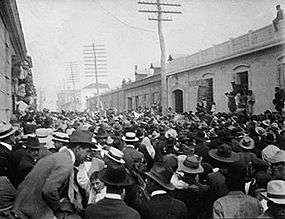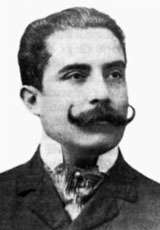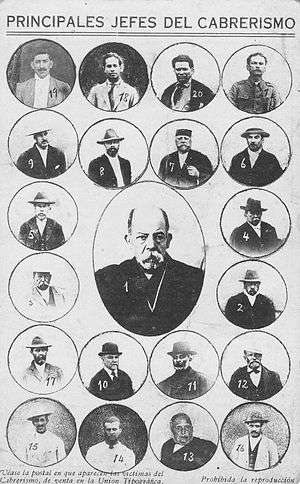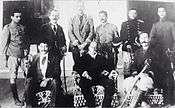Tragic Week (Guatemala)
 Time has come for president Estrada Cabrera: the Unionists party take him away after he was destroyed Guatemala's children, while Jesus holds Guatemala and remids her that she most forgive. | |
| Native name | Semana Trágica de 1920 |
|---|---|
| Date | April 8, 1920 |
| Location | Guatemala |
The Tragic Week of 1920 was a civil uprising that took place in Guatemala in the week of April 8 to April 14, 1920, led by the Unionists Party leaders, student leaders and who fought against president Manuel Estrada Cabrera when the latter refused to leave office after the National Assembly declared him mentally incapable for presidency and name Carlos Herrera as interim president.
Background
Unionists Party


Several attacks had been made on president Manuel Estrada Cabrera's life, but fortune had always been on his side.[1] He based his power entirely on the support of the military, even though he was a civilian, and when the country declared war on Germany during the First World War, made use of the opportunity to increase his already well-equipped artillery by the addition of modern field guns, machine guns and ammunition.[2]
Opposition to his regime started after the 1917-1918 earthquakes as it was evident that the President was incapable of leading the recovery efforts. Bishop of Facelli, Piñol y Batres from the Aycinena family, began preaching against the government policies in the San Francisco Church in 1919, instructed by his cousin, Manuel Cobos Batres. For the first time, the Catholic Churc opposed the President.[Note 1] Additionally, Cobos Batres was able to inflame the nationality sentiment of conservative criollo leaders José Azmitia, Tácito Molina, Eduardo Camacho, Julio Bianchi and Emilio Escamilla into forming a Central America Unionist party and oppose the strong regime of Estrada Cabrera. The Unionist party began its activities with the support of several sectors of the Guatemala City society, among them the Universidad Estrada Cabrera students[Note 2] and the labor associations, who under the leadership of Silverio Ortiz founded the Patriotic Labor Committee.[3]
The new party was called "Unionist", to differentiate it from both the Liberal and Conservative parties and therefore be able to appeal all "good willing, freedom and democracy loving" men who "dreamed of the Central America Union". The headquarters of the new party were in a house belonging to the Escamilla family which soon was known as "People's House".[4] Tácito Molina wrote a founding Act for the party, which was signed by fifty one citizens on 25 December 1919 and was later known as the "Three-fold Act" because it had to be folded in three when it was distributed to the citizens of the city. The document was distributed in Guatemala City until January 1, 1920.[5]
March 11, 1920


Estrada Cabrera was forced to accept the new party due to the internal and international pressure. On March 1, 1920, the National Assembly officially accepted the new party. Since then, Estrada Cabrera publicly admitted his willingness to accept the international opinion on opening spaces for political rivals, but kept arresting Unionist sympathizers.
Ever since January, the Unionists had been taking a more threatening attitude openly challenging the Government; they had also been annoyed and imprisoned, but they were treated with less severity than had been the case with former similar attempts.[6] It was whispered, however, that in case of need, the whole country would side with the Unionists.[6]
On 11 March 1920, the new party organized a large demonstration against the government, partly demanding a new government, revision of the laws, administrative reforms, political freedom, and the abolition of the press censorship.[6] The National Assembly leaders promised to receive them, but when the procession - numbering several thousands - arrived at the Military Academy, where the National Assembly had moved after the 1917-18 earthquakes, the army fired their machine guns against it leaving scores of dead and wounded on the ground.[1] This caused a lot of resentment and anger and united the Guatemalan people against the President, who was already detested after two decades of strong ruling and, especially, his evident incompetence to lead a decent recovery after the 1917-18 earthquakes.[7]
April 8, 1920


Prince Wilhelm and his companions returned to Guatemala City on April 8, 1920, and wrote on his book that "there was a sort of feeling in the air as of something was about to happen".[9] The prince had no way to know that the previous days Unionists leaders Julio Bianchi and Tácito Molina, among others, had struck a deal with Congress leaders, specially Adrian Vidaurre that on this day, the National Assembly would declare the president unfit for his high office.[10] Congress assembled in one of the public buildings of the city and requested that ten medical men should be deputed to go to "La Palma" and investigate; the ten departed willingly enough, but being perfectly aware that their instructions would have been a death sentence, they stopped at a close corner, wait for a few hours and returned later to Congress with their decision: the president is insane, sure enough.[11]
Then, congress President Adrián Vidaurre, former Secretary of War and up to that point one of the most important members of Cabrera's cabinet, declared the President insane and unable to continue and designated citizen Carlos Herrera as interim president.[12]
Herrera, then a representative from his hometown Santa Lucía Cotzumalguapa, had been elected partly on account of his good repute, partly because of his distinguished personal qualities and his great wealth, which should have rended him less likely to enrich himself at others' expense.
Soon, great bodies of people were marching through the streets, shouting and waiving hands and congratulating each other. Cars and other vehicles drove back an forth, packed with people and some people procured tin cans and toy trumpets to add to the noise,[13] while in government buildings and barracks the soldiers simply looked on. Most of the soldiers had been bought over and had promised to remain neutral until they knew better.[14]
But Estrada Cabrera was not done yet; upon learning the news, he simply said: "Loco, ¿eh? ¡Ya verán su loco!" -"Mad, huh? They will see their madman!"-.[15]
Tragic week April 9–14, 1920
April 9, 1920
Cabrera resisted this designation and settled for a fight from his residence in "La Palma", which was a large enclosed area with roads crossing both ways, without any real aspect of park or garden arrangement. Tumbled together in a group were some small buildings, painted in the crudest colors; each house appeared to be built for some particular purpose: one was the dining room, another the kitchen, a writing room, and so on. The structure had little open spaces, was blazed in the sun and had wonderful landscapes painted on the walls. At a little distance were straw-thatched huts with a lone broad bench used for bed and table for servants and soldiers.[16]
On April 9, 1920, Guatemala City was awakened with machine-gun fire and shells dropping close in every quarter of the city. In "La Palma" French field-howitzers and seventy-fives with anti-aircraft sights, quick firing guns and machine guns were drawn up;[17] on the other hand, in Guatemala City streets were deserted and bloodshed commenced in earnest.[14] The Unionists were caught off-guard: their organization was deficient, and they had almost no weapons, but they were able to remedy the situation. Government buildings were systematically plundered and ransacked and they got arms and ammunition from the most unlikely places; this way they got knives, machetes, saloon rifles, shotguns, axes and crowbars. With enthusiasm, all men raised barricades and dug trenches in the streets.[18]
The shooting at first accounted for as many friends as enemies, but after white badges bearing the name "Unionista" were distributed, the fire was more effective.[18] A few hours later all males in the city were wearing that token in their hat, and there were even some that had a portrait of the new president on their chest. On the government side, steady fire was maintained from "La Palma" and the two forts of San José and Matamoros. Cars with the Red Cross flag dashed incessantly, carrying a sister on the footboard with her medical supplies on one hand and a machete stuck in her belt.[19]
After the combats, the water supply pipes and electric cables were damaged, leaving the city in darkness from the first night; telephone and telegraph were also out of order. The wildest rumors were the only source of news while bullets whistled about one's ears. It was a revolution, which, thanks to the modern weapons, was really hard fought.[20]
April 10–13, 1920
During these days there was reason to fear that the Cabrerists might attempt to outflank the city and fall upon the revolutionaries from the rear, causing each to defend himself as best he could in the confusion;[21] and several times a truce was proclaimed, only to be broken a few minutes later.[22] The Prince and his companions remained at the Hotel, which thanks to its solid walls and corrugated iron roof withstood most of the rifle and shrapnel bullets; there, earth from the flower tubs in the patio was stuffed into sacks to build a bomb-proof shelter for women and children and old tram-lines from the street outside were torn up and used for the roof. Finally, using debris and dust from a nearby demolished building -destroyed by the 1917-18 earthquakes- the guests were arable to barricade the main entrance to the building.[23]
The first couple of days, one ducked and ran as fast as one could across a street, but later one took things more calmly, and waited till the fire slackened. Plundering was rampant, to the point that a store was ransacked across the street from where the Swedish prince was staying. From what was left, he managed to find a flag from Venezuela, which he used to make a crude Swedish flag that remained on the outside of a hotel window for the rest of the events, notifying both sides that it was a foreign legation.[24]
April 14, 1920

Combat lasted until San José fort fell due partly to hunger and partly to buying the defenders, for the fort commanded the position at "La Palma" entirely. By the following afternoon the revolutionaries were absolute masters of the situation. The firing gradually ceased and Estrada Cabrera surrendered, along with the remainder of his forces, numbering about five thousand.
Aftermath
After the fighting was over, the damage was not as widespread as initially thought with San José and the Central Prison suffering most of it. However, houses surrounding both structures (which were close to each other) were peppered with bullets and the streets were partly turned up. The Infant's Asylum was hit by a shell, which killed on the spot about thirty mothers and their newborn children.[26]
In "La Palma" the former garrison marched out as prisoners of war. All were well nourished and contented and carried away their belongings on their backs while Estrada Cabrera was transported to the Military Academy under diplomatic escort.[27] After taking all of them away plundering was in full swing; officers saw the other way as the ransacking was beyond control and everybody got whatever one could. In a few hours, every article of value had vanished and even the sheets of roofing or window fasteners were pulled off. Even the elegant landau that once belonged to the president was stolen, along with its thoroughbred mules.
Built in the "Candelaria Barrio" by Rafael Carrera solely because that was his birthplace, Matamoros fort lacked any strategic advantage is it was practically within the city. However, its star formation walls had firearms coming out of any loop-hole, angle and tower; from little Colt machine guns to bit 12 cm. Krupp guns from 1877. All their available weaponry had been used and was left pointed towards the city in the end. On the wall of the commandant's quarters hung a detailed artillery map of the city and, close by, Estrada Cabrera's last order -dated six days previously- for the establishment of an extra telephone line to "La Palma". [28] Six great cellars were piled high with heaps of ammunition and the powder kegs stood in long rows; a paper on a door leading to the smaller chambers read that there were ca. four millions rounds of machine gun ammunition. There was also abundant supply of flour while meet had run out when the last mule was shot.[29]
San José fort was in similar situation as that of Matamoros, but with the difference that the ammunition had been more recklessly expended, for the ground was so piled with empty cases that it was difficult to walk.[29] Given the large ammunition at the ex-president's disposal it was remarkable that he surrendered so soon; but the troops were unreliable, deserting in great numbers to the Unionists at every opportunity. Several hundreds of them went missing every night during the Tragic Week, after which those who were left were killed on the spot by their officers if they tried to escape.[30] Hunger weakened the troops that were still fighting, but not because of lack of supplies but rather due to miserable management of the commissariat.[30]
Several attempts were made to take the Military Academy by force and lynch the former president, but they all were strongly repelled by the Unionists guards as the party leaders were steadfast on returning to a democracy as soon as possible, although they could not prevent that an excited mob lynched twelve Cabrerists with clubs and machetes in Central Square. It could not prevent either a large fire that destroyed the central railway station; thick and suffocating clouds of smoke poured over the city, literally obscuring the sun. Otherwise, the leaders regained control and three days later, Guatemala city had regained its normal appearance; there was not festive celebration of the victory as people had other things to think about, and too many were in mourning for the 800 killed and couple of thousand wounded.[31]
Estrada Cabrera loyal adherents until the end

Estrada Cabrera finally surrendered on April 14, 1920 along with his only loyal friend, Peruvian poet José Santos Chocano.[32]
 |
The people whose portraits are shown here were captured along Estrada Cabrera after he surrendered in La Palma or were killed during the "Tragic Week" events. There are, according to the number written on their picture:
|
 |
Other close collaborators were:
|
-

With his Army Staff the day after his resignation.
-

With family and children after his resignation.
See also
Notes and references
Notes
- ↑ The Catholic Church at the time was very weak and had only the secular clergy left; regular clergy orders had been expelled from Guatemala in 1872 by the liberal regimes of Justo Rufino Barrios and did not come back to the country until after the coup against Jacobo Árbenz Guzmán in 1954.
- ↑ Universidad de San Carlos was called Universidad "Estrada Cabrera" since 1918.
References
- 1 2 Wilhelm of Sweden 1922, p. 189.
- ↑ Wilhelm of Sweden 1922, p. 190.
- ↑ Ortiz Rivas 1922.
- ↑ Hernández 1930, p. 50.
- ↑ Arévalo Martínez 1945, p. 319.
- 1 2 3 Wilhelm of Sweden 1922, p. 188.
- ↑ Arévalo Martínez 1945, p. 408.
- 1 2 Arévalo Martínez 1945, p. 497.
- ↑ Prins Wilhelm 1922, p. 188.
- ↑ Bianchi Smout 1941, p. XIV-XVI.
- ↑ Prins Wilhelm & 1922 189-190.
- ↑ Arévalo Martinez 1945, p. 408-412.
- ↑ Wilhelm of Sweden 1922, p. 191.
- 1 2 Wilhelm of Sweden 1922, p. 192.
- ↑ Arévalo Martinez 1945, p. 414.
- ↑ Prins Wilhelm 1922, p. 202.
- ↑ Prins Wilhelm 1922, p. 203.
- 1 2 Prins Wilhelm 1922, p. 193.
- ↑ Prins Wilhelm 1922, p. 194.
- ↑ Wilhelm of Sweden 1922, p. 194.
- ↑ Prins Wilhelm 1922, p. 197.
- ↑ Prins Wilhelm 1922, p. 196.
- ↑ Prins Wilhelm 1922, p. 196-197.
- ↑ Prins Wilhelm 1922, p. 199.
- ↑ Prins Wilhelm 1922.
- ↑ Prins Wilhelm 1922, p. 200-201.
- ↑ Prins Wilhelm 1922, p. 201.
- ↑ Prins Wilhelm 1922, p. 205.
- 1 2 Prins Wilhelm 1922, p. 206.
- 1 2 Prins Wilhelm 1922, p. 207.
- ↑ Prins Wilhelm 1922, p. 208.
- ↑ Montenegro 2005.
- ↑ De los Ríos 1948, p. 54.
- 1 2 Unión Tipográfica 1920, p. 2.
Bibliography
- Arévalo Martínez, Rafael (1945). ¡Ecce Pericles! (in Spanish). Guatemala: Tipografía Nacional.
- Bianchi Smout, Julio (1941). Prólogo de "¡Ecce Pericles!" de Rafael Arévalo Martínez (in Spanish). Guatemala: Tipografía Nacional.
- Bucheli, Marcelo; Jones, Geoffrey G. (May 27, 2005). "The Octopus and the Generals: the United Fruit Company in Guatemala". Harvard Business Review.
- Bucheli, Marcelo (2006). "The United Fruit Company in Latin America: Business Strategies in a Changing Environment". In Jones, Geoffrey; Wadhwani, Daniel. Entrepreneurship and Global Capitalism. 2. Cheltenham (UK): Edward Elgar. pp. 342–383.
- Buchenau, J. (1996). In the Shadow of the Giant, the Making of Mexico's Central America Policy (1876-1930). Univ of Alabama Pr; edition: Vintage Intl. ISBN 0-8173-0829-6.
- Ortiz Rivas, Silverio (1922). Reseña histórica de la parte que el elemento obrero tuvo en el Partido Unionista (in Spanish). Guatemala: unpublished.
Partially reproduced in ¡Ecce Pericles! by Rafael Arévalo Martínez
- Unión Tipográfica (1920). "Principales jefes del Cabrerismo" (in Spanish). Guatemala: Unión Tipográfica.
- Vidaurre, Adrián (1921). Los últimos treinta años pasados de la vida política de Guatemala (in Spanish). La Habana, Cuba: Imprenta Sainz, Arca y Cía.
- Prins Wilhelm (1922). Between two continents, notes from a journey in Central America, 1920. London, UK: E. Nash and Grayson, Ltd. pp. 148–209.
External links
![]() Media related to Semana Trágica de Guatemala (1920) at Wikimedia Commons
Media related to Semana Trágica de Guatemala (1920) at Wikimedia Commons
Coordinates: 14°37′22″N 90°31′53″W / 14.6228°N 90.5314°W